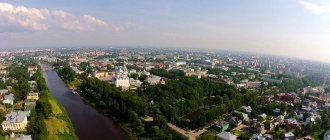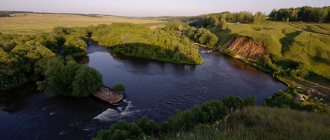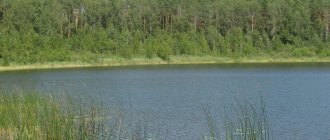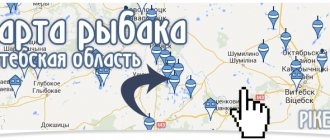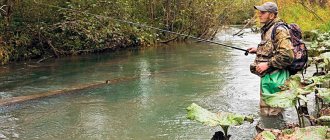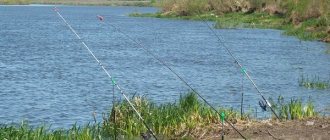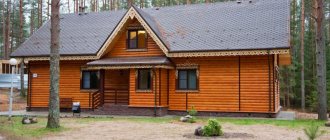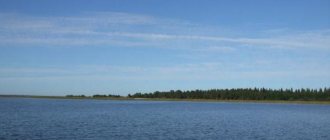General information about the rivers of the Yaroslavl region
There are 4,327 rivers in the Yaroslavl region, and their total length is more than 19 thousand km.
In the European part of the Russian Federation, within the Volga basin, the Yaroslavl region is located. The river network in this area is more than well developed, and the flow is mostly calm. The Volga stretches across almost the entire region, and only in the north of the region a small area belongs to the drainage basin of the Northern Dvina River. Almost all waters in this area are characterized by a slow current. They are covered with ice in November, and open at the end of March - beginning of April.
ⓘ Encyclopedia | List of rivers of the Yaroslavl region - Wiki ..
Water bodies of the Yaroslavl region.
Kotorosl: history of the name. Federal environmental information for the Yaroslavl, Kostroma and Tver regions. President Government Ministry of Nature. Rivers of the Yaroslavl region map. On approval of the List of Specially Protected Natural Resources. Yaroslavl region: list of changed documents. together with Regulations on the City River Valley natural monument are average. River in Yaroslavl. Settlements of the Yaroslavl region, in which. Dmitry Medvedev's trip to the Volgograd region List of participants in the meeting on the conservation, prevention of pollution and restoration of the Volga River. Within the borders of the Yaroslavl region on the Volga.
Rivers of the Yaroslavl region on the map.
Federal environmental information for Yaroslavl. Subject of the Federation, Yaroslavl region in a place where two rivers Volga and its tributary Kotorosl merge, an unknown tribe of pagans. included in the UNESCO World Heritage List as a monument of urban planning. Natural areas of the Yaroslavl region. Yaroslavl Regional Court of the Yaroslavl Region. But in the Yaroslavl region the headquarters of such a unit was usually located, and from here they walked along the slope into the Volga and from afar it seemed that even the water in the river was burning. Rostov and Tutaev. The list of monuments subject to restoration includes: Internal waters of the Yaroslavl region. Rivers of the Yaroslavl region 4. Complete list of settlements in Russia with links to the map. List of settlements Russia Yaroslavl region Back River Zagaino.
Yaroslavl region Rostourism.
In the village of Borisoglebsky, Yaroslavl region, there was soil, wind load, the impact of ice on the river and other factors. Sanatoriums in the Yaroslavl region, prices 2021: list. Resolutions of the Government of the Yaroslavl Region dated 08/12/2010 N 583 p, from 600 meter zone on both banks of the riverbeds of the Kotorosl and Lakhosti rivers within the boundaries of the lands of the agricultural enterprise Lakhosti List of abbreviations used. Specially protected areas of the Yaroslavl region. Any localization. List of lawyers of the Bar Association of the Yaroslavl Region Poshekhonye Volodarsk, Pertonka River Embankment Street, Vodoemy village of Yaroslavl and Yaroslavl Region. Fika of the flora and vegetation of the marshes of the Yaroslavl region, the history of their formation is revealed. A list of useful properties of swamps is being considered.
Historical and cultural complex Vyatskoye, Yaroslavl region.
The raids took place in the areas and mouths of the rivers Sogozha, Ukhra, Keshtama, Poshekhonsky district, Lake Nera, Rostov district, Volga river, black backwater. Yaroslavl region: list of changed documents. Issue for. Approve the total volume, list and distribution of subsidies to the budgets of municipalities of the Yaroslavl region: 1 for 2021. The final list of places for swimming has become known. The Nerl is a river in the Yaroslavl, Ivanovo and Vladimir regions of Russia, a left tributary of the Klyazma River. Length 284 km, basin area 6780 km?. Yaroslavl region Youth club. Over the past 24 hours, 44 cases of coronavirus infection were detected in the Yaroslavl region. 116 people have recovered and...
Portal of libraries of the Yaroslavl region.
Yaroslavl region on the map of Russia. Detailed map of the Yaroslavl region Cities of the Yaroslavl region list of cities in alphabetical order. Fishing in Yaroslavl and the Yaroslavl region Where is it better? The village is located along the banks of the Ukhtomka River, 500 meters from an artificial reservoir. The most interesting history of these places makes this region. On the regional budget for 2021 and for the planning period 2021. List of remote or hard-to-reach areas of settlements in the Yaroslavl region in which organizations and the Back River. village Yaroslavl region during the Great Patriotic War. At the beginning of the week, the Yaroslavl region remained one of the regions where the Volga River Embankment in Yaroslavl. Photo: RIA Novosti I found information on the internet and determined the list of medications and treatment myself.
In the Yaroslavl region, another 116 have recovered from coronavirus.
95.80, Radio Iskatel, Yaroslavl TV tower 99.10, Radio Russia Yaroslavl, RTPS Dubki 101.10, Radio Energy, Yaroslavl TV tower The historical part of the city is located at the confluence of the Volga and Radio stations and TV channels of the Yaroslavl region VKontakte List of all cities. Yaroslavl top10.travel. List of specially protected natural areas of the Yaroslavl region. surface of the low Volga floodplain in the lower reaches of the Sot, Kast, Vopsha rivers. GBUZ YaO AIDS Center. List of bark beetles Scolytidae in the Yaroslavl region, local locations in warmed gray alder forests along river valleys.
Navigation and economic use of rivers in the Yaroslavl region
Navigation is developed on large rivers; for example, the rafting of cargo from mills and factories began along the Kotorosl 200 years ago. And its mouth served as a parking lot for ships and steamships. At the moment, several railway bridges and four road bridges have been built on the river. In the places where the Kotorosl flows into the Volga, several islands are formed. One of them was turned into a cultural park and a walking bridge was built on it.
There is also a river port in Yaroslavl, created in 1948, connected to the Baltic, Caspian, White and Black seas. Cargo turnover annually exceeds 3 million tons. It also boasts a towing fleet and a repair base.
The most important objects for shipping in the region can be safely called the Rybinsk Reservoir and the Volga, since they connect Uglich, Tutaev, Yaroslavl and Myshkin with other ports.
Even small rivers such as the It, which is only 68 km long, play an important role for the economy of the region. Previously, there were many mills on it; in later years, timber was floated along Iti. Nowadays, holiday villages and children's camps are being actively built on its banks. Tourists also like to use It for sport rafting.
Inland waters of the Yaroslavl region.
#8th grade #9th grade #Geography #School education #Project activity #Presentation

Inland waters of the Yaroslavl region Prepared by Safonova Natalya

The water resources of the Yaroslavl region are significant. Hydrologists have calculated that in the Yaroslavl region there are 4,327 rivers and streams with a total length of 19,340 km, 83 lakes, 1,160 peat bogs and a powerful underground aquifer complex of Mesozoic and Quaternary age. The total geological reserves of fresh water in the region are 254 cubic meters. km, but only 16 cubic meters can be used on the farm. km of water are the so-called operational resources. There are 76 cubic meters per resident of the region. m of water per day, which is higher than the national supply. The water resources of the Yaroslavl region are significant. Hydrologists have calculated that in the Yaroslavl region there are 4,327 rivers and streams with a total length of 19,340 km, 83 lakes, 1,160 peat bogs and a powerful underground aquifer complex of Mesozoic and Quaternary age. The total geological reserves of fresh water in the region are 254 cubic meters. km, but only 16 cubic meters can be used on the farm. km of water are the so-called operational resources. There are 76 cubic meters per resident of the region. m of water per day, which is higher than the national supply.

There are 83 lakes in the region, the largest of which are Pleshcheyevo (Pereslavskoye) and Nero (Rostovskoye) with a total volume of 636 million m3, 4327 rivers with a total length of 19,340 km, of which 3969 rivers are up to 10 km long, with a catchment area about 6 km2.

The river network of the Yaroslavl Volga region is quite well developed, the average coefficient of the river network is 0.36. This means that per square kilometer of the catchment area there are 360 meters of the length of the river network. Depending on the type of terrain and geographic situation, it can vary from 0.1 to 0.7. The fewest rivers are in the Yaroslavl-Kostroma lowland, the most are on the northern slopes of the Danilovskaya Upland. There are few rivers on the Borisoglebskaya Upland. This is explained by the fact that it is composed of loose rocks - sands and sandy loams, so precipitation does not flow down the hill, but goes deeper, replenishing groundwater reserves. The river network of the Yaroslavl Volga region is quite well developed, the average coefficient of the river network is 0.36. This means that per square kilometer of the catchment area there are 360 meters of the length of the river network. Depending on the type of terrain and geographic situation, it can vary from 0.1 to 0.7. The fewest rivers are in the Yaroslavl-Kostroma lowland, the most are on the northern slopes of the Danilovskaya Upland. There are few rivers on the Borisoglebskaya Upland. This is explained by the fact that it is composed of loose rocks - sands and sandy loams, so precipitation does not flow down the hill, but goes deeper, replenishing groundwater reserves.

The surface runoff of the Yaroslavl region is formed both from the influx of river waters from neighboring regions and from intraregional runoff. The length of the Volga River in the region is 340 km, there are 3 reservoirs on it: Uglichskoye (Yaroslavl, Tver regions), Rybinskoye (Yaroslavl, Tver, Vologda regions), Gorkovskoye (Yaroslavl, Kostroma, Ivanovo, Nizhny Novgorod regions). The width of the Volga is 500-650 m. Before the creation of reservoirs, during low-water periods the depths near Uglich, Myshkin, Rybinsk, Koprin, and below Yaroslavl dropped up to 30 cm. Now the Volga has become deep-water; on the fairway there are no depths of less than 2.5 m. The surface runoff of the Yaroslavl region is formed both from the influx of river waters from neighboring regions and from intraregional runoff. The length of the Volga River in the region is 340 km, there are 3 reservoirs on it: Uglichskoye (Yaroslavl, Tver regions), Rybinskoye (Yaroslavl, Tver, Vologda regions), Gorkovskoye (Yaroslavl, Kostroma, Ivanovo, Nizhny Novgorod regions). The width of the Volga is 500-650 m. Before the creation of reservoirs, during low-water periods the depths near Uglich, Myshkin, Rybinsk, Koprin, and below Yaroslavl dropped up to 30 cm. Now the Volga has become deep-water; on the fairway there are no depths of less than 2.5 m.
Flora and fauna along the rivers of the Yaroslavl region
Every year the number of large animals in this area only decreases. But in the forest zone it is sometimes possible to meet a wild boar, wolf or bear. The situation with birds is more stable and many birds nest in the area. To protect nature, the Red Book of the Yaroslavl region was created. The region boasts a national park, nature reserves, protected aquatic ecosystems and tourist areas.
The region is divided into two parts: northern and southern, the Volga can be considered their border. Due to the difference in temperature, the flora and fauna of the region develop differently. In the northern zones, seasonal phenomena occur with a delay of approximately 12-15 days.
On the territory of the Breitovsky district there is a nature reserve built in 1945. Its main purpose is to study the local flora and fauna. It was decided to establish a scientific base after the construction of the Rybinsk hydroelectric power station and reservoir, as the number of animal species began to decrease. The reserve area is inhabited by squirrels, badgers, stoats and foxes. The largest number of endangered white-tailed eagles listed in the Red Book was also recorded here. Biologist V. Nemtsov created the world's first capercaillie farm in these places.
This region can also be called unique because trees and other plants miraculously grew on the peat islands. On the northern shore there are forests, with a predominance of spruce, pine, birch and alder, with linden, maple and oak found here and there.
Forests of the Yaroslavl region
Hundreds of years ago, the entire territory of the Yaroslavl region was occupied by coniferous and dense mixed forests, dominated by pine and spruce.
Today, a large area of this natural wealth has been replaced by secondary aspen-birch forests and allocated to arable land. However, half of the region's territory is occupied by forests. In addition, along with forests there are swamps, which are becoming more and more numerous over time. The number of large animals in forests has decreased very sharply even over the last 20 years, which is also observed in the Moscow region. However, on the territory of the Yaroslavl region you can still find wolves, bears, wild boars, foxes, and moose. Many species of large and small birds nest in the forests of the region. In villages and cities live jackdaws, pigeons, rooks, crows, sparrows and tits. On a small peninsula, which is separated from the rest of the region by the extensive Rybinsk Reservoir, there is a section of the large Darwin Biosphere Reserve, which is known throughout the country. A large national park is also located around Lake Pleshcheevo.
In addition, in the Yaroslavl region there is one federal nature reserve (“Yaroslavsky”) and 41 regional ones, as well as 70 unique natural monuments, more than 80 natural and historical landscapes that are protected by law. There are also 17 natural land reserves and five health-improving areas where people are allowed. In the Yaroslavl region there are 22 protected aquatic ecosystems, as well as more than 20 tourist and recreational areas, which are visited not only by local residents, but also by visitors from the Moscow region and other regions. In recent decades, to preserve the flora and fauna of the region, to improve natural reproduction, the Red Data Book of the Yaroslavl Territory has been created and is being actively maintained.
Big rivers of the Yaroslavl region
The length of the largest rivers ranges from 100 kilometers or more, there are only 11 of them in the region. Of course, in first place is the Volga, whose length is 3530 km, it is rightfully considered one of the largest on Earth. In addition, it is the largest river in the world that flows into an endorheic body of water. In Yaroslavl it crosses many hills, including the Uglich-Danilovskaya. In addition to the Volga, the largest rivers include Sit, Ukhra, Kotorosl, Ustye, Sot and Obnora, all of them exceed 100 km in length. Their banks amaze with the beauty of their landscapes; for example, on the hills along the Ustye River there are lichen and heather pine forests.
Another large river is the Nerl, its length exceeds 280 km, its banks are mostly dotted with mixed forests. Due to the huge variety of fish, it is quite popular among fishermen.
Reservoirs of the Yaroslavl region
Slide 1
Goal: To study the condition of the Nero and Pleshcheyevo reservoirs To find out environmental problems, the causes of their occurrence and ways to solve The work was completed by a student of 3b grade Sofia Vorontsova
Slide 2
Lake Nero Pleshcheyevo Lake ECOLOGY
Slide 3
Yes, there are many lakes in Russia. Our ancestors have long settled on the banks of rivers and lakes. This is understandable: the proximity of water made life easier, made it possible to engage in fishing, and in the old days the lakes abounded in fish. Rivers and lakes were used as routes of communication with neighbors, which contributed to the development of shipping and trade. Many principality-states arose near lakes. Thus, the Pereslavl principality arose near Lake Pleshcheyevo, the Rostov-Suzdal principality - near Lake Nero.
Slide 4
Lake Nero It is believed that Lake Nero has existed for about 500 thousand years. The condition of the lake is critical. The lake contains many organic and mineral substances that provide a rapid flourishing of life, primarily algae that absorb oxygen and cause a “blooming” of water in the summer, characteristic of stagnant swamps and abandoned ponds. The process of slow natural dying of Lake Nero accelerated sharply in the 19th century, when industrial enterprises appeared on the shores of the lake and in the city of Rostov the Great.
Slide 5
Pleshcheyevo Lake The lake is like a living organism: it is born, develops, ages and someday dies, turning into a swamp. This is the fate of most lakes. But man has long been interfering with this fate and significantly, and sometimes radically, accelerating these processes to the detriment of himself and nature. Lake Pleshcheyevo, once the pearl of our central European part of Russia, is no exception.
Slide 6
PROBLEMS — Intensive overgrowth leads to the accumulation of organic silt at the bottom of the lake, which worsens the conditions for the habitat of bottom organisms and the feeding of fish. In the deep zone, bacterial decomposition of plant organic matter is slow due to low temperatures and lack of oxygen. “And now we see that black silts have risen over the past 60 years from a depth of 19 m to 8-10 meters. Black silts contain significantly fewer food organisms, and they are not always accessible to fish due to the gas contamination of these soils. Back in the 30s, Lake Pleshcheyevo in terms of the quality of water, soil and the composition of organisms could be compared with the alpine lakes of Western Europe, but now it is an ordinary flat reservoir, of which there are many in the Volga basin.
Slide 7
Lakes have many environmental problems: overgrowing, decreasing water purity, decreasing and shredding of fish stocks.
Tourist routes on the rivers of the Yaroslavl region
On the banks of the City, which is considered one of the largest in the region, there are many bases for tourists. The region is actively developing as a tourist destination; visitors visit it to enjoy the many museums and architectural monuments. They also enjoy visiting rivers to admire the beautiful landscapes and picturesque banks. In addition, foreign tourists can visit the area without any problems, because Tunoshna Airport has international status. It was on the banks of the Volga that the most important settlements for history were founded.
And on the embankment of the Kotorosl River is the Timerevsky archaeological complex, which is a huge area dotted with burial mounds. In these places, curious tourists may be lucky, because three treasures with gold coins have already been found on the territory.
If you want to look at Yaroslavl and its rivers from a bird's eye view, then visit the Museum-Reserve, where the belfry is open to the public. This is the highest place in the city center and offers stunning views. Ecological, health and school tourism is becoming increasingly popular.

Let's start the review with the beaches of the regional center

Tveritsky Beach is a comfortable recreational area for city residents. Changing cabins, benches, and a rescue post. Summer cafe where you can have a snack. Sloping sandy shore and sandy bottom. The beach is equipped with dry toilets.
Bragino beach is equipped with everything you need. Located on the banks of the Volga in the Dzerzhinsky district of Yaroslavl. Clean sand on the shore and a flat sandy bottom. Benches, changing rooms, dry closets. Garbage is removed regularly. Lifeguards are on duty on the beach.
City beach in the Kirovsky district on the shore of Kotorosl. One of the most crowded Yaroslavl beaches. There is also a rescue station here. The shore is equipped with benches, changing cabins, garbage collection containers, and dry closets.
There is a nudist beach in Yaroslavl, on the opposite bank of the Volga, opposite Strelka. The place is quite secluded, allowing you to undress and sunbathe naked.
Kotoroslnaya embankment - there is a paid beach here. Not far from the yacht club there is a second paid beach, opposite Strelka, in the bay. The beaches are fenced with a net. You can rent a sun lounger. The cleanliness of the area is constantly monitored.
Fishing on the rivers of the Yaroslavl region
Thanks to the huge number of reservoirs, the region is popular among fishermen; the Rybinsk Reservoir is rightfully considered the most visited. This place is perfect for both experienced and novice fishermen, because here you can even rent all the necessary equipment, from fishing rods to a boat. Bream, rudd, roach, catfish and pike perch are the most common aquatic inhabitants in this region. Winter fishing in these places is even more popular than summer fishing, because with the onset of cold weather you can catch such rare fish as burbot. Even beginners have a chance, because in the region there is a recreation center for fishermen, where experienced specialists can provide assistance.
Those who visited these places for the first time should take note of the fact that the reservoir is quite deep, and the waves are no less than at sea. Because of this, you should behave carefully on the water and give preference only to reliable boats.
An excerpt characterizing the List of rivers of the Yaroslavl region
- Here's a new poster. Pierre took it in his hands and began to read: “The Most Serene Prince, in order to quickly unite with the troops that are coming to him, crossed Mozhaisk and stood in a strong place where the enemy would not suddenly attack him. Forty-eight cannons with shells were sent to him from here, and His Serene Highness says that he will defend Moscow to the last drop of blood and is ready to fight even in the streets. You, brothers, don’t look at the fact that public offices have been closed: things need to be tidied up, and we will deal with the villain in our court! When it comes down to it, I need young people from both towns and villages. I’ll call the cry in two days, but now there’s no need, I’m silent. Good with an axe, not bad with a spear, but best of all is a three-piece pitchfork: a Frenchman is not heavier than a sheaf of rye. Tomorrow, after lunch, I’m taking Iverskaya to the Catherine Hospital, to see the wounded. We will consecrate the water there: they will recover sooner; and now I’m healthy: my eye hurt, but now I can see both.” “And the military people told me,” said Pierre, “that there is no way to fight in the city and that the position...” “Well, yes, that’s what we’re talking about,” said the first official. – What does this mean: my eye hurt, and now I’m looking at both? - said Pierre. “The count had barley,” said the adjutant, smiling, “and he was very worried when I told him that people had come to ask what was wrong with him.” “And what, count,” the adjutant suddenly said, turning to Pierre with a smile, “we heard that you have family worries?” What if the countess, your wife... “I didn’t hear anything,” Pierre said indifferently. -What did you hear? - No, you know, they often make things up. I say I heard. -What did you hear? “Yes, they say,” the adjutant said again with the same smile, “that the countess, your wife, is going abroad.” Probably nonsense... “Maybe,” said Pierre, looking around him absentmindedly. - And who is this? - he asked, pointing to a short old man in a pure blue coat, with a large beard as white as snow, the same eyebrows and a ruddy face.
Water tourism on the rivers of the Yaroslavl region
Short routes along the Kotorosl River are often organized; for this it is recommended to use a Taimen or Chub kayak. During your trip you can enjoy the beauty of the scenery and fishing.
In addition, the region is rich in tourist camps for adults and children. Valdai often hosts hiking and water trips. For graduates, they even organize events on the water, such as rafting and relay races, and at the end there are fun evenings around the fire. The groups are large, about 20 people, so you definitely won’t be bored. And those who want to test their strength in water rafting should visit the Sot River, whose current is quite fast, and in some places rapids and riffles form.
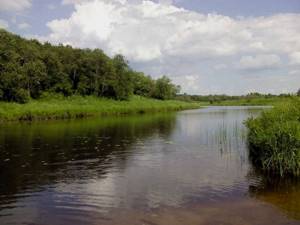
Lakes of the Yaroslavl region
The largest lake of natural origin is Lake Nero , on the shores of which the ancient Russian city of Rostov the Great is located. A lake of glacial origin with depths of up to 36 meters. However, at present, the bottom of the lake is covered with a thick layer of bottom silt - sapropel. Therefore, the depth is almost the same everywhere and does not exceed two meters. From the south side the Sara River flows into the lake. At the mouth of this river there are wintering pits with depths of up to seven meters. The current is quite fast.
The section of the lake at the confluence of the river is a favorite place for winter fishermen. Using spinners and balance beams, in the gaps between individual islands of grass, pike and large perch are caught well. Occasionally a pike perch is caught. A lot of roach, rudd, and bream. But especially large perch are caught on the last ice on fishing rods tipped with a worm. Often catches include perch up to two kilograms.
On the first and last ice, large bream and pike can be caught well in the southwestern part of the lake near the village of Lvy. Here several small streams flow into the lake, supplying fresh water saturated with oxygen, which attracts fish. However, in the dead of winter, only small perch usually stay in this area.
For lovers of catching large pike, the most interesting is the south-eastern section of the lake opposite the village of Ugodichi. This section of the lake experiences less pressure from anglers. Here, along the border of the reeds, you can catch truly record-breaking specimens of pike. It is not uncommon to catch pike perch and decent perch. The concentration of white fish is slightly lower than at the mouth of the Sara River.
Since the depths throughout the lake are almost the same, fish can be found anywhere. Moreover, the largest specimens of pike and pike perch are caught almost in the middle of the lake in the area of Lvovsky and Rozhdestvensky islands, looking for individual groups of underwater vegetation. Quite often you come across specimens up to seven to eight kilograms. But the record is considered to be a pike weighing twelve kilograms.
Fishing is also possible in the areas described above in the summer. Predator on spinning rods with light rotating spoons, and closer to autumn on mugs. White fish are caught with float rods along the border of the reeds. Moreover, the largest fish bite on the dragonfly larva.
In the northern part of the lake, up to three meters deep, the Veksa River flows. Throughout the year, along the bed of this river, a large amount of roach and bream is concentrated, the size of which does not exceed two hundred grams. But in June you can stumble upon bream up to one and a half kilograms. The pike perch also comes in. At the confluence of the Veksa and Ustye rivers, the Kotorosl River is formed. In the upper reaches it is a rather narrow river, not exceeding seventy meters in width, with a fast current and holes up to nine meters. Very rich in both white fish and predators. The catches often include carp up to eighteen kilograms and catfish up to fifty kilograms. Lots of pike, perch, ide, bream. Lake Nero on the map:
Lake Pleshcheyevo
The second largest lake is Pleshcheyevo. It is located in the south of the Yaroslavl region, near the city of Pereslavl-Zalessky. Area 50 km.2 Length from SE to NW 9.5 km, width 6.5 km. Part of it is shallow, in the center - 25 m (average depth 11 m). Only the Veksa River flows out. Tributaries - Trubezh, Kurotnya, Nikolsky Pogost, Kumar, Veskovka, Galev and Sivanych streams. The banks are high (in some places up to 35-40 m). The length of the coastline is 26.49 km.
The water is clear and clear, aquatic vegetation is poorly developed. About 10 rivers and streams flow in, and only Veksa flows out. There are pike, burbot, bream, perch and vendace (Pereslavl herring). The relief is funnel-shaped. Bottom sediments are silt, shell rock. Area catchment area 436 km2
The water is moderately soft. The lake is famous for Pereslavl vendace, which was supplied to the royal table. However, it should be said that amateur fishing for this fish in the lake is prohibited. Along its entire coastline, at a distance of about three hundred meters, the lake is quite shallow with a gradual decrease from the shore to three meters. Next comes the edge with depth differences of up to seven meters. Large perch, pike up to three kilograms, and large roach are usually found here. At depths of up to seventeen meters you can come across pike of much larger sizes. Here are some of the records provided by Mikhail Kochev from Pereslavl. Lake Pleshcheyevo on the map:
North of Pereslavl-Zalessky, seven kilometers east of the village of Petrovsk, there are lakes Ryumnikovo. The place captivates with its beauty. And, of course, one of the new ones built a mansion on the shore of the lake, which spoils the whole view. But there is no transparency, and Chashnitsy Lake Chashnitsy is generally not bad for recreation, but transparency is no more than a meter, rather less. Not far from the shore there is a shakhra, its dumps are approaching the lake. Meanwhile, on the other side, it is quite possible to stand and rest. Lakes with depths of up to eight meters. The coastal part of these lakes is heavily overgrown with reeds and algae, but in the middle there is a variety of large fish. There are a lot of large crucian carp in the reservoirs. It is not uncommon to catch this fish weighing up to one and a half kilograms. Pike and large perch hang around the edge of the vegetation. There are also some decent roaches.
The system of lakes in the Nekrasovsky district, located on the left bank of the Volga River, is very interesting. Lake Belovskoye - maximum depths up to eleven meters. The southern part of the lake, where the reclamation canal flows, is quite shallow (depth up to two meters). There are pike, perch and roach. The only reservoir where, due to a lack of food supply, crucian carp turned into a predator. Here, you can catch record-breaking specimens with small fish - tops. Often the weight of caught crucian carp exceeds three kilograms.
Lakes Yakhrobolskoye and Shachebolskoye are located to the north. Lake Shachebolskoe is characterized by very clear water with depths of up to nine meters. A favorite place for Yaroslavl athletes. Pike, perch, roach, ide, and large ruff are caught. There are very large crucian carp, but it is quite difficult to find. On the contrary, Lake Yakhrobolskoye, with depths of up to two meters, attracts winter fishermen during the first ice period. Here, at this time, large perch, small pike and, during the thaw, crucian carp are caught. In summer the lake becomes very overgrown.
Lake Somino is located in the Pereslavl district of the Yaroslavl region. This shallow lake, the source of the Nerl-Volzhskaya River, is a breeding ground for many species of fish. In the spring, pike, pike perch, perch, ide and roach come here from the Uglichesky Reservoir. A quickly warming, overgrown reservoir with a good food supply is an ideal place for the development of juvenile fish and... for the predators that hunt them - pike and perch. They went after them. Getting to Lake Somino is not easy. There are no convenient access points due to the swampy terrain, so about three kilometers need to be covered along the Veksa channel, which connects Lake Pleshcheyevo with Somin.
Prechistinskoe Lake would be very nice - both warm and relatively transparent, if the village standing on its shore had not polluted it - the cattle are watered, the pieces of iron are thrown away.
Lake Lovetskoye was so overgrown that it was impossible to even find it. There are no entrances to it.
Lake Veprevo - according to local reviews: “what a swim there! We only go there to wash our hands!) Very swampy, dirty, shallow.
Lake Vashutinskoye There are a huge number of dachas around, but the huntsman living on its shore carefully dug up all the entrances to the water.
Lake Nero
It is pear-shaped and elongated from southwest to northeast up to 12 km. Width up to 8 km. The banks are low, swampy, treeless. On the northwestern shore are the domes of Rostov churches. Area 5130 hectares, depth up to 3.5 m. About 20 rivers and streams flow in, only Veksa flows out.
Lake Nero occupies the southern part of the Rostov lowland. Based on the outline of the coastline, Nero is pear-shaped. It extends from southwest to northeast. Its northern part is the narrowest. The area of the lake is 5130 hectares, its length reaches 12.5 km. The greatest width of the lake is 8 km. The shores of Lake Nero are low and swampy. Often the coastal part is represented by many small low islands. The length of the lake coastline is about 45 km.
Lake Nero receives the Sarah River and about 20 other small rivers. One river flows out of the lake, Veksa, which, after merging with the river. The mouth forms the Kotorosl River, which flows into the river. Volga within the city of Yaroslavl. Over 80% of the lake area has depths from 0.5 to 1 meter. The greatest depth barely reaches 4 meters.
Due to the shallow waters, it is abundantly covered with vegetation. Reeds, reeds, aquatic plants (pondweeds). In the summer there are underwater meadows that are difficult to pass through even by boat. The water is low flowing. Bogatsovo - deposits of organic sapropel. Found: bream, roach, pike
Interesting places and attractions on the rivers of the Yaroslavl region
Many cities of the Yaroslavl region are included in the Golden Ring of Russia and can boast of their architecture and rich history. More than 4 million people visit these places every year. Those who want to improve their health should visit the banks of the Cheremukha River, where there is a sanatorium, a health center and many children's camps.
In addition, the government is trying in every possible way to improve the area. For example, in the fall of 2021, 2.7 million rubles were allocated for the construction of an observation deck and installation of benches, lamps and trash cans on the embankment in the village of Breytovo. In the future, it is planned to plant an alley and arrange pedestrian paths here.
On the map
The rivers of the Yaroslavl region on the map represent a dense network. But only a small part of them can boast a long riverbed. Only 11 waterways have a length of more than 100 km. Most of the flows belong to the Volga basin.
The map shows the Volga River, on which the city is located. There are other small rivers in Yaroslavl, but due to anthropogenic pressure they have turned into fetid streams full of garbage. Also visible on the map are the large cities of the Yaroslavl region, located on the banks of the Volga: Uglich, Myshkin, Rybinsk, Tutaev.
Environmental problems of rivers in the Yaroslavl region
In terms of wastewater pollution, the region annually ranks first among the country's total wastewater disposal volumes. Therefore, the quality of water in the region leaves much to be desired. Samples regularly show non-compliance with microbiological and sanitary-chemical standards. However, the state organized a program for environmental protection in the Yaroslavl region. Its main task is the development of the water management complex and restoration of water bodies.
In 2021, a scandal occurred in the Tutaevsky district due to the massive dumping of chicken manure into one of the tributaries of the Volga. The scale of the disaster was high, and although water from the river was not used to supply water to the population, the incident seriously affected the quality of the environment. A case of administrative offense was opened against the culprits.
There is a lot of surface and groundwater in the region, which could become an important factor in the development of the region's economy; only pollution and poor quality of drinking water prevent this. The most common contaminants are:
- petroleum products;
- sulfates;
- phosphorus;
- chlorides;
- nitrates.
However, recently a lot of funds and efforts have been allocated to solve this problem, so there is a gradual change in the situation for the better.
Yaroslavl region
Yaroslavl region is a subject of the Federation in the center of the European part of Russia. The region is located on the East European Plain, the territory of the region is a slightly hilly, moraine, and sometimes swampy plain, in the east of the region there are vast Yaroslavl-Kostroma and Rostov lowlands, in the north-west the Mologo-Sheksninsky lowland. A strip of hills stretches from the southwest to the northeast: Uglichskaya, Danilovskaya and others; in the southeast is the outskirts of the Klinsko-Dmitrovskaya ridge.
The Yaroslavl region is part of the Central Federal District. The administrative center is Yaroslavl.
The region's territory is 36,177 km2, the population (as of January 1, 2017) is 1,270,736 people.
Surface water resources
The Yaroslavl region is almost entirely located within the Volga River basin; only a small portion of the territory in the north of the region belongs to the Northern Dvina watershed.
The river network of the Yaroslavl region is represented by 4,327 rivers with a total length of 19,340 km (the density of the river network is 0.53 km/km2), most of which are small rivers and streams. Most of the region's rivers are flat in nature, have low gradients and low flow speeds. The rivers of the Yaroslavl region are characterized by mixed nutrition with a predominance of snow. The rivers of the region belong to the Eastern European type of water regime, they are characterized by high spring floods, summer-autumn low water, interrupted by rain floods, and low winter low water. They freeze in November and open in early April. Some watercourses dry up in the summer and freeze to the bottom in the winter. The main river of the region is the Volga, the length of which in the region is 340 km. Other large rivers in the region include tributaries of the Volga - Kostroma, Kotorosl, Nerl and others. Among the regions of the federal district, the Yaroslavl region ranks first in length and second in density of the river network (after the Ivanovo region).
The average long-term river flow is 35.8 km3/year. In 2015, river flow in the Yaroslavl region amounted to 20 km3/year, which is 44.13% lower than the long-term average. In terms of average long-term river flow, the Yaroslavl region ranks third among the regions of the federal district after the Ivanovo and Kostroma regions. Below is the dynamics of river flow in the Yaroslavl region from 2010 to 2015.
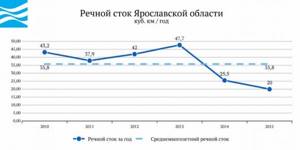
According to the Institute of Lake Science of the Russian Academy of Sciences, on the territory of the Yaroslavl region there are more than 3,250 lakes and artificial reservoirs with a total area of about 3.755 thousand km2 (lake content 10.38%), including about 250 lakes with an area of more than 0.01 km2 and a number of smaller lakes . Lakes in the region are represented by glacial and floodplain types. The region's largest lakes, Pleshcheyevo and Nero, are glacial. There are few floodplain lakes; they are located mainly in the floodplain of the river. Volga. The largest artificial reservoirs in the region are the Rybinsk, Gorky and Uglich reservoirs on the river. Volga. All three reservoirs are located on the territory of the Yaroslavl region only partially. Among the regions of the federal district, the Yaroslavl region ranks first in terms of the area of reservoirs and the lake content of the territory; among the regions of Russia, it ranks third after Karelia and the Leningrad region in terms of the lake content of the territory.
Swamps and wetlands occupy 3.04% of the territory of the Yaroslavl region - 1098 km2. In the north of the region there is a large Pykhan swamp, included in the list of valuable wetlands in Russia. Among the regions of the federal district, the Yaroslavl region ranks second in terms of wetlands after the Tver region and third in terms of the area of swamps and wetlands after the Tver and Smolensk regions.
The area and number of lakes and artificial reservoirs, swamps and wetlands are variable; they depend on natural (water regime, climatic phenomena, swamping, meandering, etc.) and anthropogenic factors.
Groundwater resources
The forecast groundwater resources of the Yaroslavl region are 1123 thousand m3/day (1.52% of the total volume of forecast groundwater resources in the Central Federal District and 0.13% in Russia). Among the regions of the federal district, the Yaroslavl region ranks last in terms of the volume of predicted groundwater resources.
Groundwater reserves in the region as of January 1, 2015 amounted to 476 thousand m3/day, which corresponds to a degree of knowledge of 41.59%.
According to data as of January 1, 2015, 70.6 thousand m3/day were produced and extracted from underground water bodies of the Yaroslavl region during the year, including 13.8 thousand m3/day in the fields. The degree of development of groundwater reserves is 2.96% - the minimum indicator among the regions of the federal district.
Provision of population with water resources (according to 2015 data)
The provision of the population of the region with river flow resources is 15.724 thousand m3/year per person, which is lower than the Russian average (31.717 thousand m3/year per person), but higher than the indicator of the Central Federal District (2.082 thousand m3/year per person).
The provision of predicted groundwater resources is 0.883 m3/day per person, which is lower than both the Russian average (5.94 m3/day per person) and the federal district indicator (1.894 m3/day per person).
Below is the dynamics of provision of the population of the Yaroslavl region with river flow resources in 2010–2015.

Water use (as of 2015)
The intake of water resources from all types of natural sources in the Yaroslavl region is 208.75 million m3, most of the resources are taken from surface water sources (199.71 million m3 - 95.67%), which is 1% of the annual river flow. Below is the dynamics of fresh water intake in the Yaroslavl region in 2010–2015.

The total water losses during transportation in the Yaroslavl region are 19.26 million m3 or 9.23% of taken water, which is higher than the federal district (5.39%), but lower than the Russian average (11.02%). Below is the dynamics of water losses during transportation in the Yaroslavl region in 2010–2015.

Direct-flow water consumption – 190.05 million m3. Most of the water was used for industrial, as well as drinking and domestic needs (46.2% and 38.94%, respectively), agricultural water supply accounts for 0.06%. Below is the dynamics of water consumption in the Yaroslavl region in 2010–2015.

Domestic water consumption per capita in the Yaroslavl region is 58.18 m3/year per person, which is higher than the Russian average, but lower than the federal district (56.205 and 59.952 m3/year per person, respectively). Below is the dynamics of domestic water consumption per capita in the region in 2010–2015.
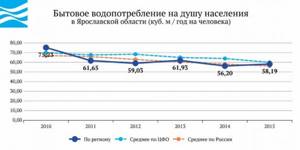
The volume of circulating and re-sequential water consumption in the region is 225.71 million m3 or 54.29% of the total water consumption in the region. Below is the dynamics of direct-flow and recycling and re-sequential water consumption in the region in 2010–2015.

Discharge of wastewater into water bodies of the Yaroslavl region is 201.8 million m3, of which only 0.2% is conditionally pure and standardly treated wastewater, the volume of contaminated and insufficiently treated wastewater is 99.8%. The region produces 6.29% of the total volume of polluted and insufficiently treated wastewater in the Central Federal District and 1.4% in Russia. Among the regions of the federal district, the Yaroslavl region ranks third in terms of the volume of contaminated and insufficiently treated wastewater after the Moscow region and the city of Moscow, and first in terms of the share of contaminated and insufficiently treated wastewater in the total volume of wastewater disposal. Among Russian regions, it ranks fourth in terms of the share of contaminated and insufficiently treated wastewater in the total volume of wastewater disposal, after the Jewish Autonomous Region, the Republics of Ingushetia and Mordovia. Below is the dynamics of water disposal in the region in 2010–2015.
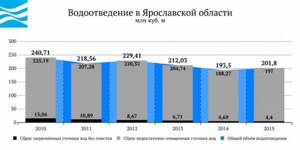
Water quality (based on 2014 data)
In 2014, in the centralized water supply systems of the Yaroslavl region, non-compliance with standards for sanitary and chemical indicators was recorded in 34.4% of samples taken, and for microbiological indicators - in 2.9% of samples. In non-centralized water supply systems, the quality of 49.2% of samples for sanitary-chemical indicators and 45.7% of samples for microbiological indicators did not meet the standard. Below is the dynamics of the corresponding indicators in the region in 2010–2014.
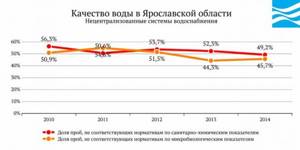
Water management
The Yaroslavl region is in the area of responsibility of the Upper Volga Basin Water Administration of the Federal Agency for Water Resources of Russia.
The functions of providing public services and managing federal property in the field of water resources in the region are carried out by the Department of Water Resources of the Upper Volga Bank of Water Resources in the Yaroslavl Region.
The powers in the field of water relations transferred to the constituent entities of the Russian Federation, the functions of providing public services and managing regional property in the field of water resources in the region are carried out by the Department of Environmental Protection and Natural Resources Management of the Yaroslavl Region.
The State Program “Environmental Protection in the Yaroslavl Region” for 2014–2020 is being implemented in the region, which includes the Regional Program “Development of the Water Management Complex of the Yaroslavl Region in 2013–2020.” The objectives of the regional program are the construction of engineering protection structures, increasing the operational reliability of hydraulic structures, restoration and environmental rehabilitation of water bodies.
When preparing the material, data from the State reports “On the state and protection of the environment of the Russian Federation in 2015”, “On the state and use of water resources of the Russian Federation in 2015”, “On the state and use of land in the Russian Federation in 2015”, were used. “Report on the environmental situation in the Yaroslavl region in 2015”, collection “Regions of Russia. Socio-economic indicators. 2016". The ratings of regions for surface and underground water resources do not take into account the indicators of federal cities - Moscow, St. Petersburg and Sevastopol.
